Roar Blu-ray Movie
HomeRoar Blu-ray Movie 
Olive Films | 1981 | 95 min | Rated PG | Nov 03, 2015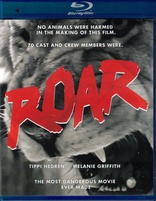
Movie rating
6.6 | / 10 |
Blu-ray rating
| Users | 0.0 | |
| Reviewer | 3.0 | |
| Overall | 3.0 |
Overview
Roar (1981)
A family takes a trip to Africa to visit their scientist father when they come afoul of some ferocious felines.
Starring: Tippi Hedren, Noel Marshall, Melanie Griffith, John Marshall (IV), Jerry Marshall (I)Director: Noel Marshall
| Thriller | Uncertain |
| Adventure | Uncertain |
Specifications
Video
Video codec: MPEG-4 AVC
Video resolution: 1080p
Aspect ratio: 2.29:1
Original aspect ratio: 2.35:1
Audio
English: DTS-HD Master Audio 2.0
Subtitles
English
Discs
50GB Blu-ray Disc
Single disc (1 BD)
Playback
Region free
Review
Rating summary
| Movie | 2.5 | |
| Video | 2.5 | |
| Audio | 3.5 | |
| Extras | 3.5 | |
| Overall | 3.0 |
Roar Blu-ray Movie Review
Me ow.
Reviewed by Jeffrey Kauffman October 31, 2015My high school Health teacher, who was also the high school football coach and therefore had the rapt attention of most of the boys by default, led a unit in sex education in Health where to a roomful of “eager” (and mostly virginal) young males he imparted the timeless wisdom, “The anticipation is greater than the realization.” That adage may be equally applicable to viewers who have heard about but never seen the patently odd Roar, a film which bears a supposed release year of 1981, but which was a multiyear ordeal for star-writer- producer-director Noel Marshall and his family, most of whom contributed to the film as either cast members or crew. This assemblage included Marshall’s then wife Tippi Hedren, Hedren’s then young daughter Melanie Griffith, and Marshall’s sons John and Jerry. Probably the very definition of a “passion project”, Roar includes a heartfelt text crawl at its close urging folks to help with efforts to protect wild species in Africa, suggesting that tourism is an appropriate way to bolster those attempts (this was obviously in the days before the rise or at least the widespread knowledge of a so-called “tourist hunter” syndrome like that which brought down Cecil the Lion). The fact that Marshall evidently thought that the way to inspire others to prevent the widespread decimation of “big cats” was to let some of those very felines apparently decimate himself, his family and his crew may lead some to wonder about the mental health of the filmmaker, especially given Marshall’s perserverance in what can only be described as a horrific series of life threatening injuries to various folks which ensued over the course of the shoot. Due to these and other breathlessly reported aspects about the film which have appeared over the years, Roar has attained something of a cult status, though perhaps ironically, many members of this putative cult have actually never seen the film, relying instead on printed accounts about the rigors of the incredibly long shoot and the hubris of some of those involved in the production to gin up their excitement. The film itself does in fact turn out to be riveting, though probably not in the way that was intended, and it's the "backstory" informing this piece that will probably continue to fascinate.
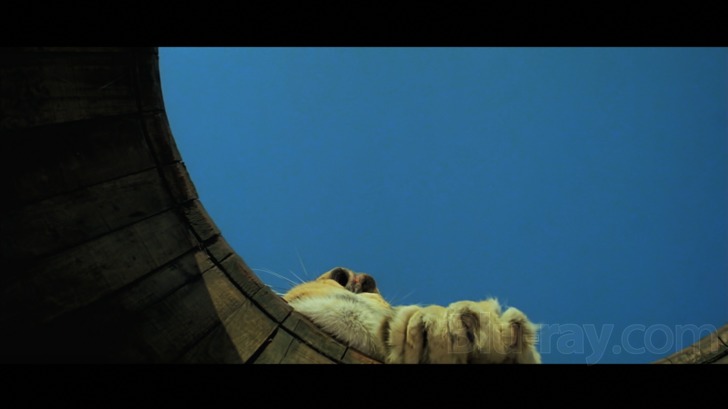
For many fans, Tippi Hedren will always be The Girl from Alfred Hitchcock’s The Birds and Marnie, and perhaps due to her contentious relationship with Hitchcock, her career after those two films has been meandering at best and maybe even lackluster at worst. By the time Roar came along in 1981, Hedren’s filmography consisted of only a handful of post-Hitchcock films, with less than stellar efforts like Satan’s Harvest and The Harrad Experiment doing little to burnish her reputation. In the meantime, Hedren had married her onetime agent Noel Marshall, a guy who in fact produced The Harrad Experiment, but who is probably best remembered (aside from Roar aficionados, that is) for having been part of the production team of The Exorcist.
While their film careers could perhaps be most generously described as hit or miss, Marshall and Hedren bonded over their love of big cats, and it was that passion that informed Roar. As many fans of Hedren know, she’s gone on to a notable advocacy position as head of the Shambala Preserve, a wildlife refuge whose existence was sparked largely by Roar itself. All of that said, Roar might seem to be a rather odd “statement” on animal rights, for its minimal plot tends to emphasize a bunch of humans screaming in terror and running from big cats, however unwarranted that behavior might be.
In fact, most of Roar’s fairly brief running time details a comedy of errors of sorts, as Hank (Noel Marshall) lives in peace with a houseful of (large) felines, helped by his native African acolyte Mativo (Kyalo Mativo). Hank’s family is due at his reserve, and he and Mativo take off to retrieve them from a bus station, but unbeknownst to Hank and Mativo, wife Madeleine (Tippi Hedren) and her three children (Melanie Griffith, John Marshall and Jerry Marshall) have already arrived and basically cross paths with the two others, getting back to the big cast infested house first, completely unaware of the “situation”.
That then devolves into one of the film's longer set pieces, where Madeleine and the kids repeatedly try to escape from the cats, while Hank has his own issues trying to get back to where he started from. This is a loose knit story arc at best, and it only fitfully supports what is the film's real drawing card, the often phenomenal scenes of (as the film itself calls them) "untrained" animals going about their business. That gives a visceral intensity to many scenes where the human actors seem to be behaving in a rather cavalier manner around these beasts of the wild. That may also be why it turned out to be the humans who were the real threatened species on this shoot, while (per that great Humane Society imprimatur) no animals were harmed.
Roar Blu-ray Movie, Video Quality 
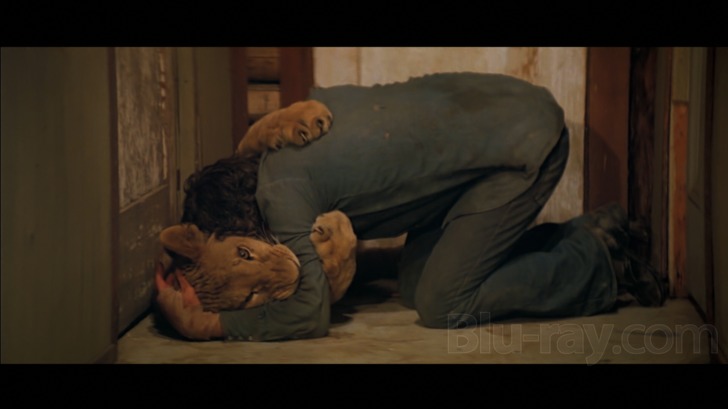
Roar is presented on Blu-ray courtesy of Olive Films with an AVC encoded 1080p transfer in 2.29:1. Roar was lensed by future all star Jan de Bont (who would go on to lens films like Die Hard and The Hunt For Red October before ultimately moving on to directing films like Speed), and de Bont's often gorgeous location footage (in both Africa and California) lends the film much of its exotic appeal. (De Bont suffered one of the more gruesome injuries during the shoot, when basically the back half of his scalp was taken off by a lion. Those with strong stomachs can find still images of his sutured head online.) Elements show a pretty standard amount of age related wear and tear, though nothing is overly problematic. The palette has weathered the vagaries of time pretty well generally speaking, and some of the shots offer really nicely vivid blue skies and other appealing hues that help to establish the wild environs. However, this transfer is marred by excessive filtering, which lends a waxy, artificial and overly processed look to many shots, especially close-ups, where pores all but disappear (though some other fine detail like downy hair can still make it through the DNR gauntlet relatively unscathed). Grain can be seen in some minimal amounts in wide shots of outdoor vistas, where slight amounts of movement can be detected on elements like background mountain ranges, but overall this has the look of processed video and not of film. Within that ambience, the palette is still relatively fresh looking and incremental amounts of detail are still able to manifest themselves, but this is not an optimal looking presentation.
Roar Blu-ray Movie, Audio Quality 
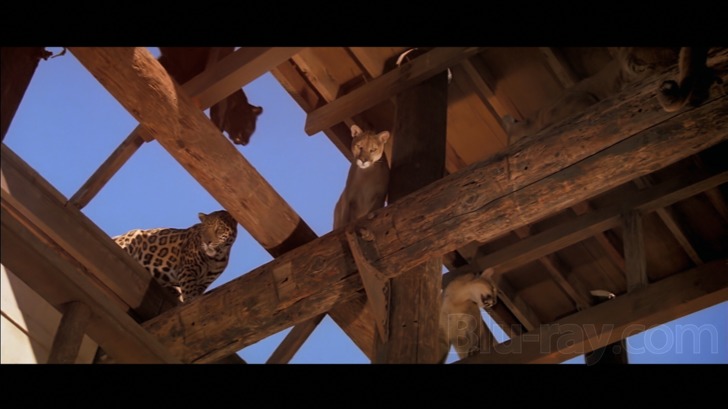
Roar features a lossless DTS-HD Master Audio 2.0 mix which provides ample support for some appealing music and elements like the cats' huge roars in either playful or more menacing moments. The film's dialogue (such as it is) is rendered faithfully as well. The track tends to have a slightly boxy sound at times, with a somewhat muffled sounding high end, but fidelity is generally very good and there's no real damage of any kind to report.
Roar Blu-ray Movie, Special Features and Extras 
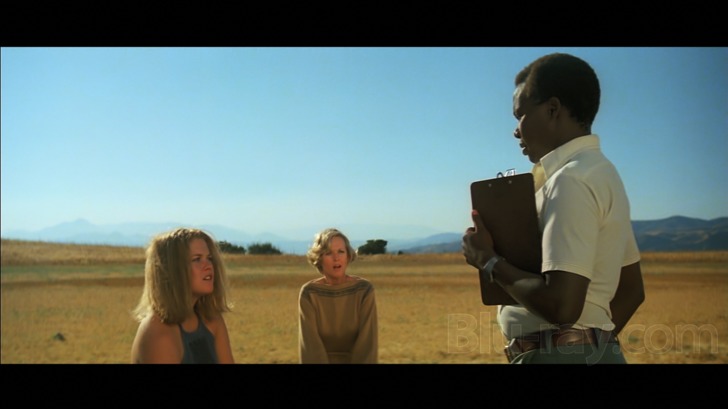
- The Making of Roar (1080p; 33:19) is a good retrospective hosted by Tippi Hedren, who recounts the traumas and triumphs of the shoot.
- Q&A with the Cast and Crew at The Cinefamily, Los Angeles, California (4/17/2015) (1080p; 39:52) features John Marshall, who's joined about halfway through by a number of the production crew.
- The Grandeur of Roar, an essay by Tim League is a text supplement which features a funny but fond account of the film's history and reputation.
- Photo Gallery (1080p; 6:26)
- Trailer (2015) (1080p; 1:43)
- Audio Commentary with John Marshall and Tim League. Marshall has a lot of interesting anecdotes about the shoot, and League keeps the conversation focused on various aspects of the film's troubled production history.
- Credits and Acknowledgements
Roar Blu-ray Movie, Overall Score and Recommendation 
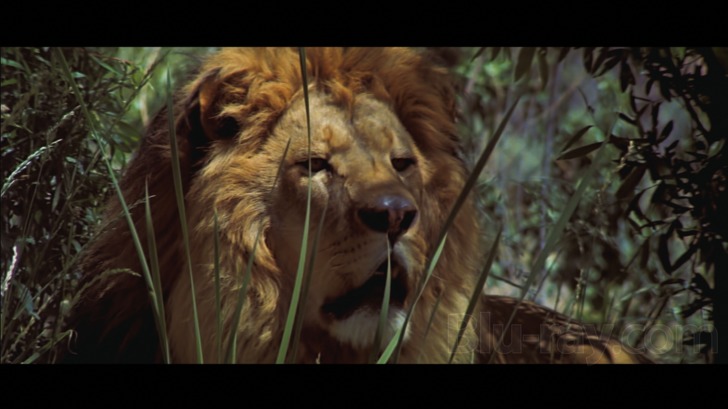
Roar's backstory is probably a good deal more compelling than the actual finished film. (This review didn't even get into tidbits like Ted Cassidy—yep, Lurch from The Addams Family—providing help with the "screenplay".) Because of that fact, this is the rare release where the content of the film and the less than stellar video presentation ultimately don't sink the final scoring status. If for no other reason, get this one for some of the supplements. Recommended.
Similar titles
Similar titles you might also like

Beast
Collector's Edition
2022

Prey
2007

Road Games
2015

Long Weekend
1978

Zombies of Mora Tau
1957

Murders in the Zoo
1933

The Pack
2015

Jackals
2016

Trapped
Limited Edition of 1,500
1982

Ants
It Happened at Lakewood Manor
1977

Primeval
2007

Treasure of the Amazon
1985

Red Scorpion
1988

The Witches
The Devil's Own
1966

Sasquatch
Sasquatch: The Legend of Bigfoot
1977

The Vengeance of She
1967

Congo 4K
Slipcover in Original Pressing
1995

Primal
2019

The Reaping
2007

Nanny
2022